Satas D., Tracton A.A. (ed.). Coatings Technology Handbook
Подождите немного. Документ загружается.

This Page Intentionally Left Blank
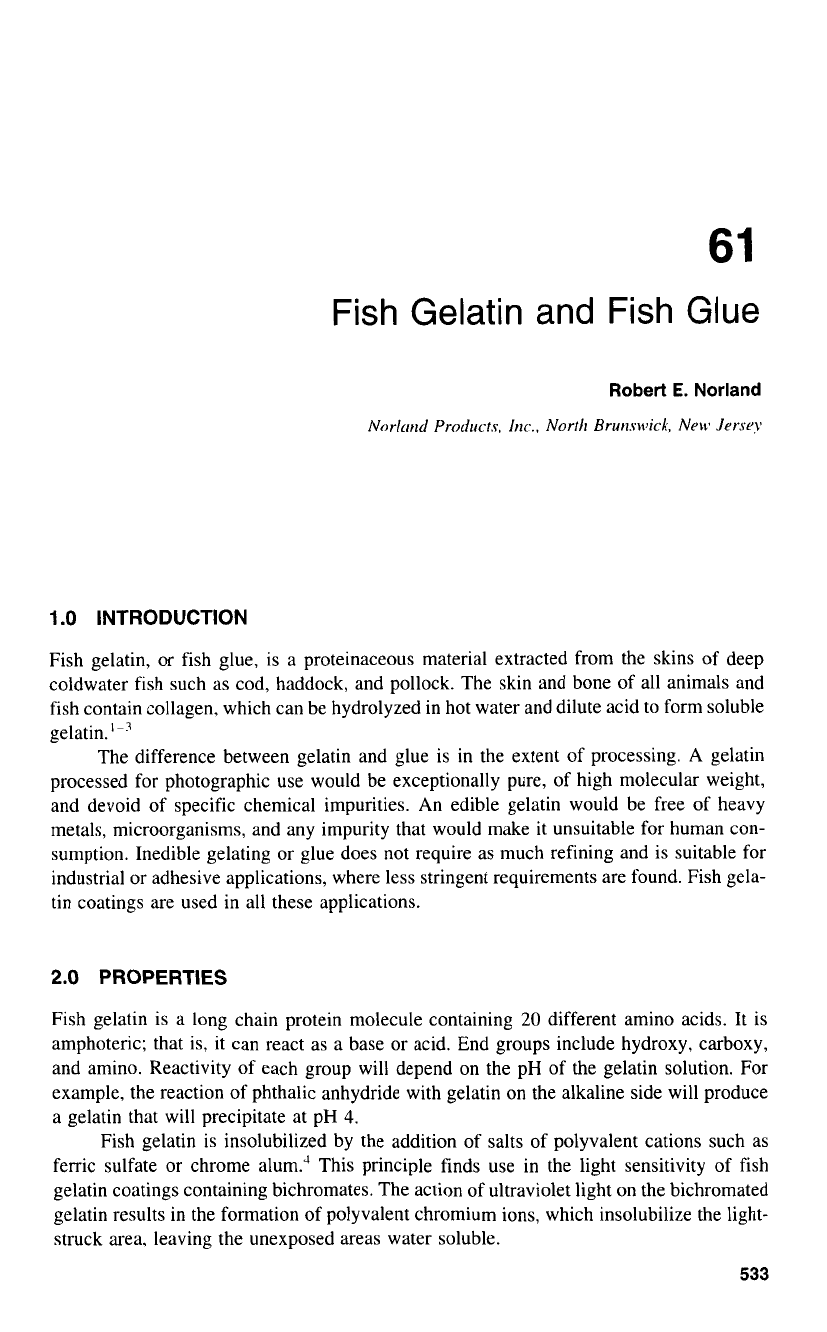
61
Fish
Gelatin and
Fish
Glue
Robert
E.
Norland
Norland Products, Inc.? North
Brunswick,
New Jersey
1
.O
INTRODUCTION
Fish gelatin, or fish glue, is a proteinaceous material extracted from the skins
of
deep
coldwater fish such as cod, haddock, and pollock. The skin and bone
of
all animals and
fish contain collagen, which can be hydrolyzed in hot water and dilute acid to form soluble
gelatin.'-3
The difference between gelatin and glue is in the extent
of
processing. A gelatin
processed for photographic use would be exceptionally pure,
of
high molecular weight,
and devoid
of
specific chemical impurities. An edible gelatin would be free
of
heavy
metals, microorganisms, and any impurity that would make it unsuitable for human con-
sumption. Inedible gelating or glue does not require
as
much refining and is suitable for
industrial or adhesive applications, where less stringent requirements are found. Fish gela-
tin coatings are used in all these applications.
2.0
PROPERTIES
Fish gelatin is a long chain protein molecule containing
20
different amino acids. It is
amphoteric; that is, it can react
as
a base or acid. End groups include hydroxy, carboxy,
and amino. Reactivity
of
each group will depend on the pH of the gelatin solution. For
example, the reaction of phthalic anhydride with gelatin on the alkaline side will produce
a
gelatin that will precipitate at pH
4.
Fish gelatin is insolubilized by the addition of salts of polyvalent cations such
as
ferric sulfate or chrome alum." This principle finds use in the light sensitivity of fish
gelatin coatings containing bichromates. The action of ultraviolet light on the bichromated
gelatin results in the formation of polyvalent chromium ions, which insolubilize the light-
struck area. leaving the unexposed areas water soluble.
533
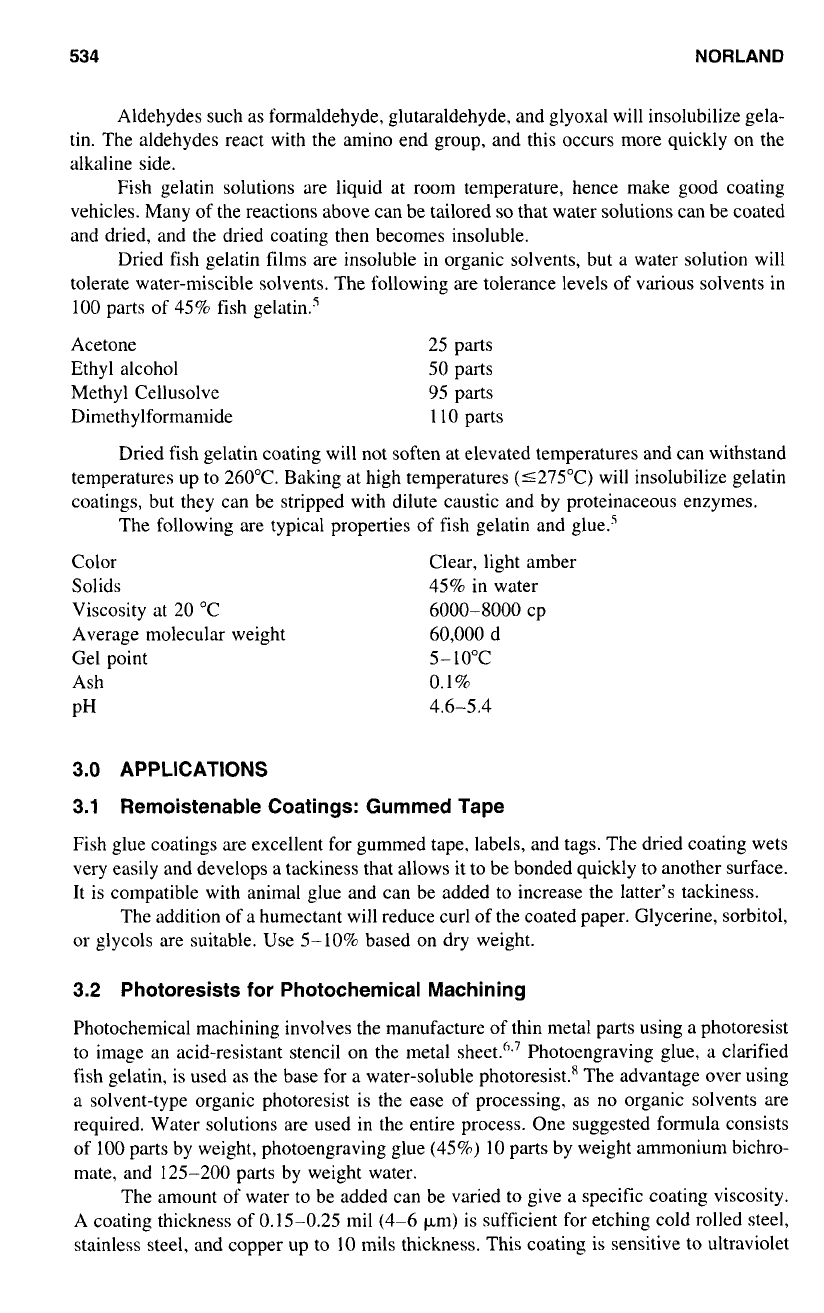
534
NORLAND
Aldehydes such as formaldehyde, glutaraldehyde, and glyoxal will insolubilize gela-
tin. The aldehydes react with the amino end group, and this occurs more quickly on the
alkaline side.
Fish gelatin solutions are liquid at room temperature, hence make good coating
vehicles. Many
of
the reactions above can be tailored
so
that water solutions can be coated
and dried, and the dried coating then becomes insoluble.
Dried fish gelatin films are insoluble in organic solvents, but a water solution will
tolerate water-miscible solvents. The following are tolerance levels
of
various solvents in
100 parts of
45%
fish gelatin.'
Acetone
Ethyl alcohol
Methyl Cellusolve
Dimethylformamide
25 parts
50
parts
1
10
parts
95
parts
Dried fish gelatin coating will not soften at elevated temperatures and can withstand
temperatures up to 260°C. Baking at high temperatures (5275°C) will insolubilize gelatin
coatings, but they can be stripped with dilute caustic and by proteinaceous enzymes.
The following are typical properties of fish gelatin and glue.'
Color
Solids
Viscosity at
20
"C
Average molecular weight
Gel point
Ash
PH
Clear, light amber
45%
in water
6000-8000
CP
60,000 d
5-
10°C
0.1%
4.6-5.4
3.0
APPLICATIONS
3.1
Remoistenable Coatings: Gummed Tape
Fish glue coatings are excellent for gummed tape, labels, and tags. The dried coating wets
very easily and develops
a
tackiness that allows it to be bonded quickly
to
another surface.
It is compatible with animal glue and can be added to increase the latter's tackiness.
The addition of a humectant will reduce curl of the coated paper. Glycerine, sorbitol,
or glycols are suitable. Use 5-10% based on dry weight.
3.2 Photoresists
for
Photochemical Machining
Photochemical machining involves the manufacture of thin metal parts using a photoresist
to image an acid-resistant stencil on the metal sheet."' Photoengraving glue, a clarified
fish gelatin, is used
as
the base for a water-soluble photoresist.8 The advantage over using
a solvent-type organic photoresist is the ease of processing, as no organic solvents are
required. Water solutions are used in the entire process. One suggested formula consists
of
100
parts by weight, photoengraving glue
(45%)
10
parts by weight ammonium bichro-
mate, and 125-200 parts by weight water.
The amount
of
water to be added can be varied
to
give a specific coating viscosity.
A coating thickness of 0.15-0.25 mil
(4-6
km)
is sufficient for etching cold rolled steel,
stainless steel, and copper up
to
10
mils thickness. This coating is sensitive to ultraviolet
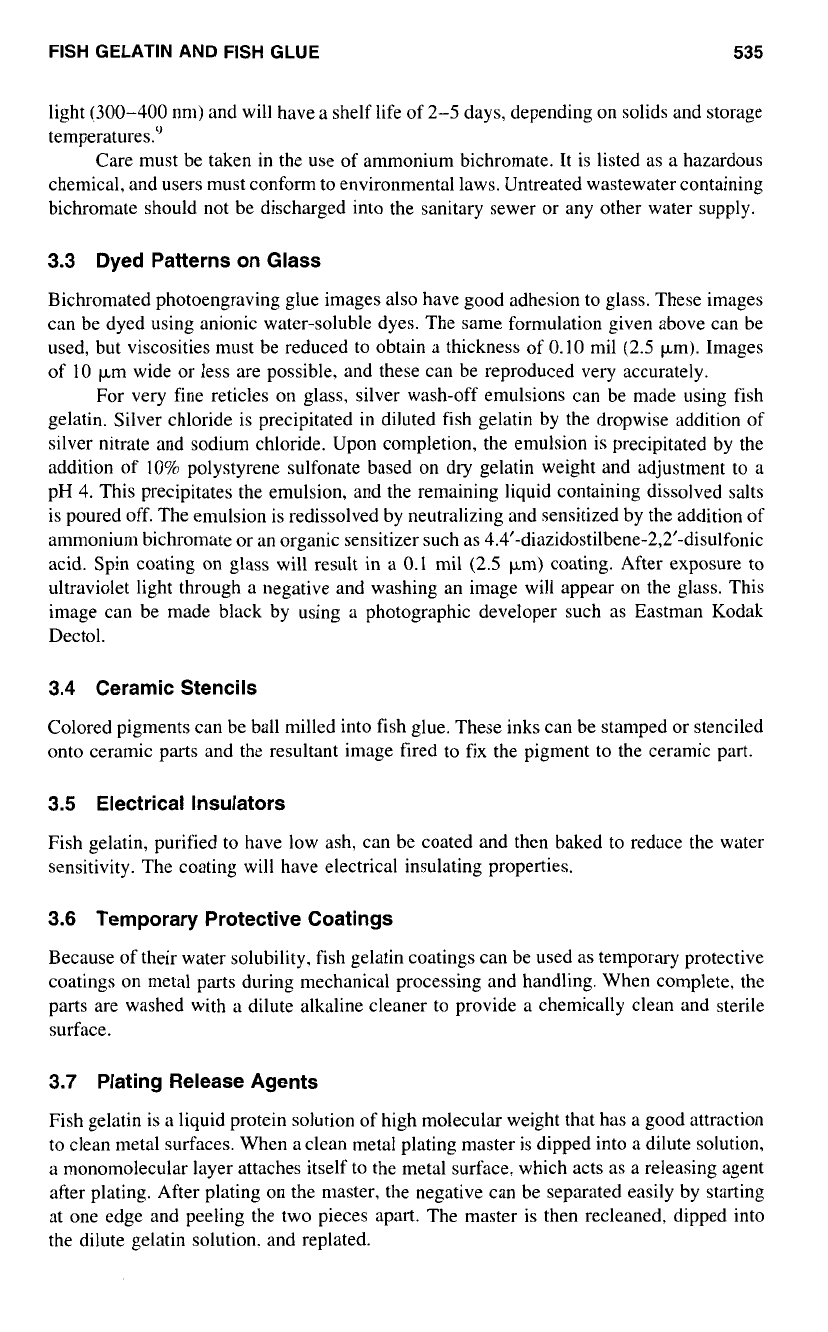
FISH
GELATIN AND
FISH
GLUE
535
light
(300-400
nm) and will have
a
shelf life
of
2-5
days, depending on solids and storage
temperatures."
Care must be taken in the use
of
ammonium bichromate. It is listed
as
a hazardous
chemical, and users must conform to environmental laws. Untreated wastewater containing
bichromate should
not
be discharged into the sanitary sewer or any other water supply.
3.3
Dyed Patterns
on
Glass
Bichromated photoengraving glue images also have good adhesion to glass. These images
can be dyed using anionic water-soluble dyes. The same fornlulation given above can be
used, but viscosities must be reduced to obtain a thickness
of
0.10 mil
(2.5
pm). Images
of
10
km wide or less are possible. and these can be reproduced very accurately.
For very fine reticles
on
glass, silver wash-off emulsions can be made using fish
gelatin. Silver chloride is precipitated in diluted fish gelatin by the dropwise addition of
silver nitrate and sodium chloride. Upon completion, the emulsion is precipitated by the
addition of 10% polystyrene sulfonate based on dry gelatin weight and adjustment to
a
pH
4.
This precipitates the emulsion, and the remaining liquid containing dissolved salts
is poured off. The emulsion is redissolved by neutralizing and sensitized by the addition
of
ammonium bichromate or an organic sensitizer such as
4.4'-diazidostilbene-2,2'-disulfonic
acid. Spin coating on glass will result in
a
0.1
mil
(2.5
pm) coating. After exposure to
ultraviolet light through
a
negative and washing an image will appear
on
the glass. This
image can be made black by using
a
photographic developer such as Eastman Kodak
Dectol.
3.4
Ceramic Stencils
Colored pigments can be ball milled into fish glue. These inks can be stamped or stenciled
onto ceramic
parts
and the resultant image fired to fix the pigment
to
the ceramic part.
3.5 Electrical Insulators
Fish gelatin, purified
to
have low ash, can be coated and then baked to reduce the water
sensitivity. The coating will have electrical insulating properties.
3.6
Temporary Protective Coatings
Because of their water solubility. fish gelatin coatings can be used
as
temporary protective
coatings on metal parts during mechanical processing and handling. When complete, the
parts are washed with
a
dilute alkaline cleaner to provide a chemically clean and sterile
surface.
3.7
Plating Release Agents
Fish gelatin is
a
liquid protein solution of high molecular weight that has
a
good attraction
to
clean metal surfaces. When
a
clean metal plating master is dipped into a dilute solution,
a
monomolecular layer attaches itself to the metal surface, which acts as a releasing agent
after plating. After plating on the master, the negative can be separated easily by starting
at one edge and peeling the two pieces apart. The master is then recleaned, dipped into
the dilute gelatin solution, and replated.
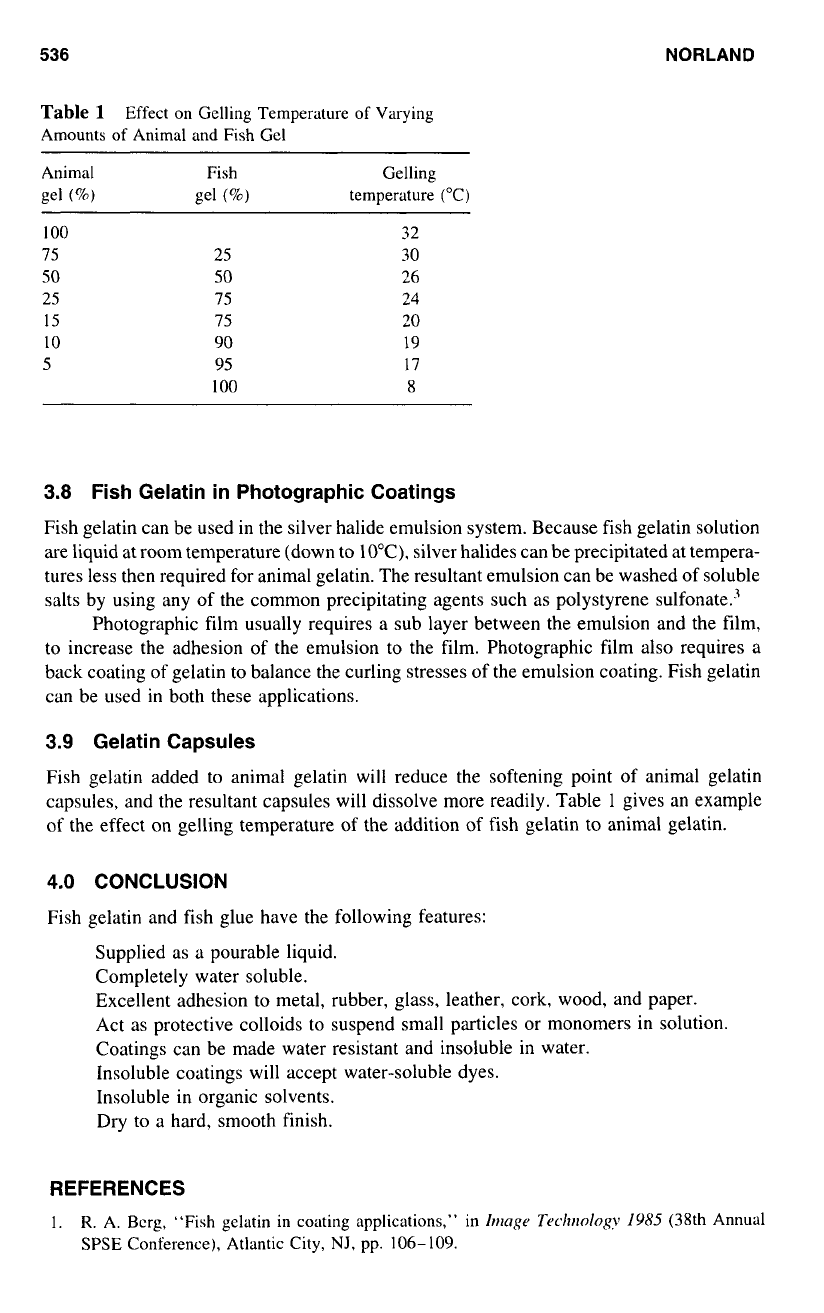
536
NORLAND
Table
1
Effect on Gelling Temperature
of
Varying
Amounts of Animal and Fish Gel
Animal Fish
Gelling
gel
(%)
gel
(%)
temperature
(“C)
IO0
32
7s
2s
30
so so
26
25
75
24
1s
7s
20
10
90
19
S
95
17
100
8
3.8
Fish Gelatin in Photographic Coatings
Fish gelatin can be used in the silver halide emulsion system. Because fish gelatin solution
are liquid at room temperature (down to 10°C). silver halides can be precipitated at tempera-
tures less then required for animal gelatin. The resultant emulsion can be washed of soluble
salts by using any of the common precipitating agents such as polystyrene sulfonate.’
Photographic film usually requires a sub layer between the emulsion and the film,
to
increase the adhesion of the emulsion to the film. Photographic film also requires a
back coating of gelatin
to
balance the curling stresses of the emulsion coating. Fish gelatin
can be used in both these applications.
3.9
Gelatin Capsules
Fish gelatin added to animal gelatin will reduce the softening point
of
animal gelatin
capsules, and the resultant capsules will dissolve more readily. Table
1
gives an example
of the effect on gelling temperature
of
the addition
of
fish gelatin to animal gelatin.
4.0
CONCLUSION
Fish gelatin and fish glue have the following features:
Supplied as a pourable liquid.
Completely water soluble.
Excellent adhesion to metal, rubber, glass, leather, cork, wood, and paper.
Act as protective colloids to suspend small particles or monomers in solution
Coatings can be made water resistant and insoluble in water.
Insoluble coatings will accept water-soluble dyes.
Insoluble in organic solvents.
Dry
to
a
hard, smooth finish.
REFERENCES
1.
R.
A. Bcrg, “Fish gelatin in coating applications,” in
bmgr
Technology
IY85
(38th Annual
SPSE
Conference), Atlantic City,
NJ,
pp. 106-109.
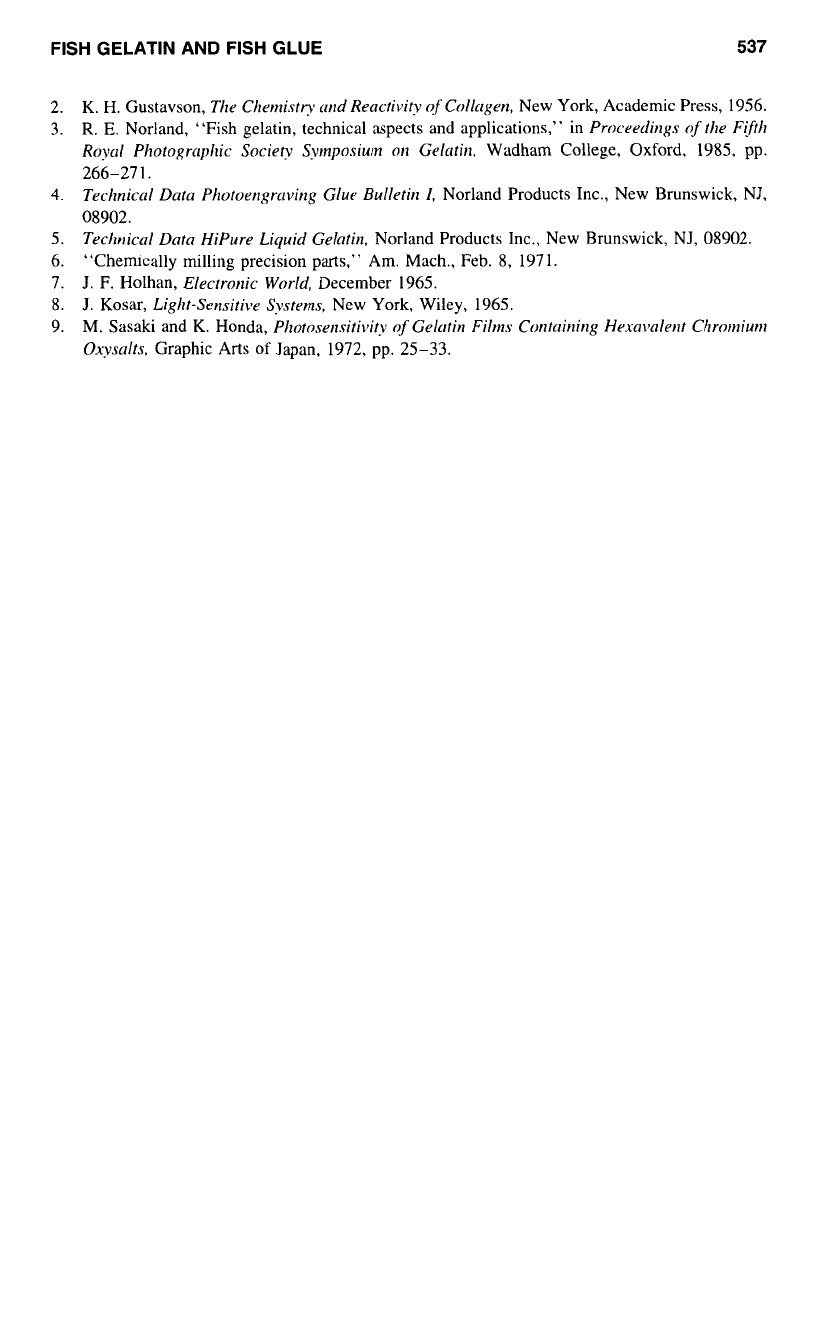
FISH
GELATIN AND
FISH
GLUE
537
2.
K.
H. Gustavson,
The Cl~ernistty rtnd Reactivity
of
Collagen,
New York, Academic Press, 1956.
3.
R.
E.
Norland, “Fish gelatin, technical aspects and applications,” in
Proceedings ofthe F$It
Royd Photogrcphic
Society
Swnposiurn
on Gehtin.
Wadham College, Oxford, 1985, pp.
266-27
1.
4.
Technical Data Photoengrming
Glue
Bulletin
l,
Norland Products Inc., New Brunswick, NJ,
5.
Technics/
Data
HiPure Liquid Gelatin,
Norland Products Inc., New Brunswick, NJ, 08902.
6. “Chemically milling precision parts,”
Am.
Mach., Feb. 8, 1971.
7.
J.
F. Holhan,
Electronic World,
December 1965.
8.
J.
Kosar,
Light-Sensitive
Systems,
New York, Wiley, 1965.
9.
M.
Sasaki and
K.
Honda,
Photoserlsitivity
of
Geldn Films Cont~tining Hcxavalertt Cl~romiutn
08902.
Uxysalts,
Graphic
Arts
of
Japan, 1972, pp. 25-33.
This Page Intentionally Left Blank
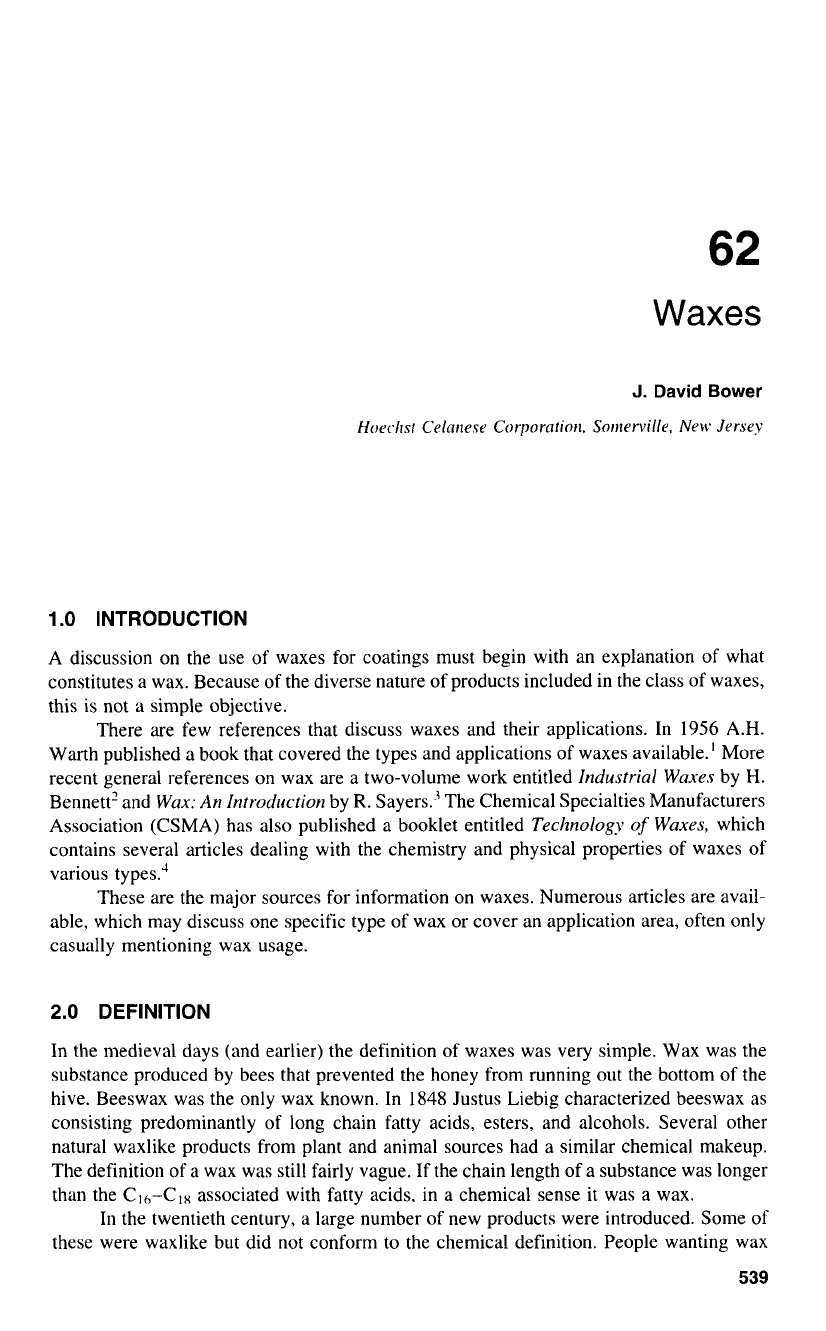
62
Waxes
J.
David
Bower
Hoechst
Celanese
Corporafiorl.
Sornewille.
New
Jersey
1
.O
INTRODUCTION
A discussion on the use of waxes for coatings must begin with an explanation
of
what
constitutes
a
wax. Because of the diverse nature of products included in the class of waxes,
this is not
a
simple objective.
There are few references that discuss waxes and their applications. In
1956
A.H.
Warth published a book that covered the types and applications of waxes available.' More
recent general references on wax are
a
two-volume work entitled
Industrial Waxes
by
H.
Bennett' and
Wax:
An
Introduction
by
R.
Sayers.' The Chemical Specialties Manufacturers
Association (CSMA) has also published a booklet entitled
Technology
of
Waxes,
which
contains several articles dealing with the chemistry and physical properties of waxes of
various types.'
These are the major sources for information on waxes. Numerous articles are avail-
able, which may discuss one specific type of wax or cover an application area, often only
casually mentioning wax usage.
2.0 DEFINITION
In the medieval days (and earlier) the definition of waxes was very simple. Wax was the
substance produced by bees that prevented the honey from running out the bottom
of
the
hive. Beeswax was the only wax known. In
1848
Justus Liebig characterized beeswax as
consisting predominantly of long chain fatty acids, esters, and alcohols. Several other
natural waxlike products from plant and animal sources had
a
similar chemical makeup.
The definition of
a
wax was still fairly vague. If the chain length of a substance was longer
than the
Clh-CIX
associated with fatty acids. in
a
chemical sense it was a wax.
In
the twentieth century, a large number of new products were introduced. Some of
these were waxlike but did not conform
to
the chemical definition. People wanting wax
539
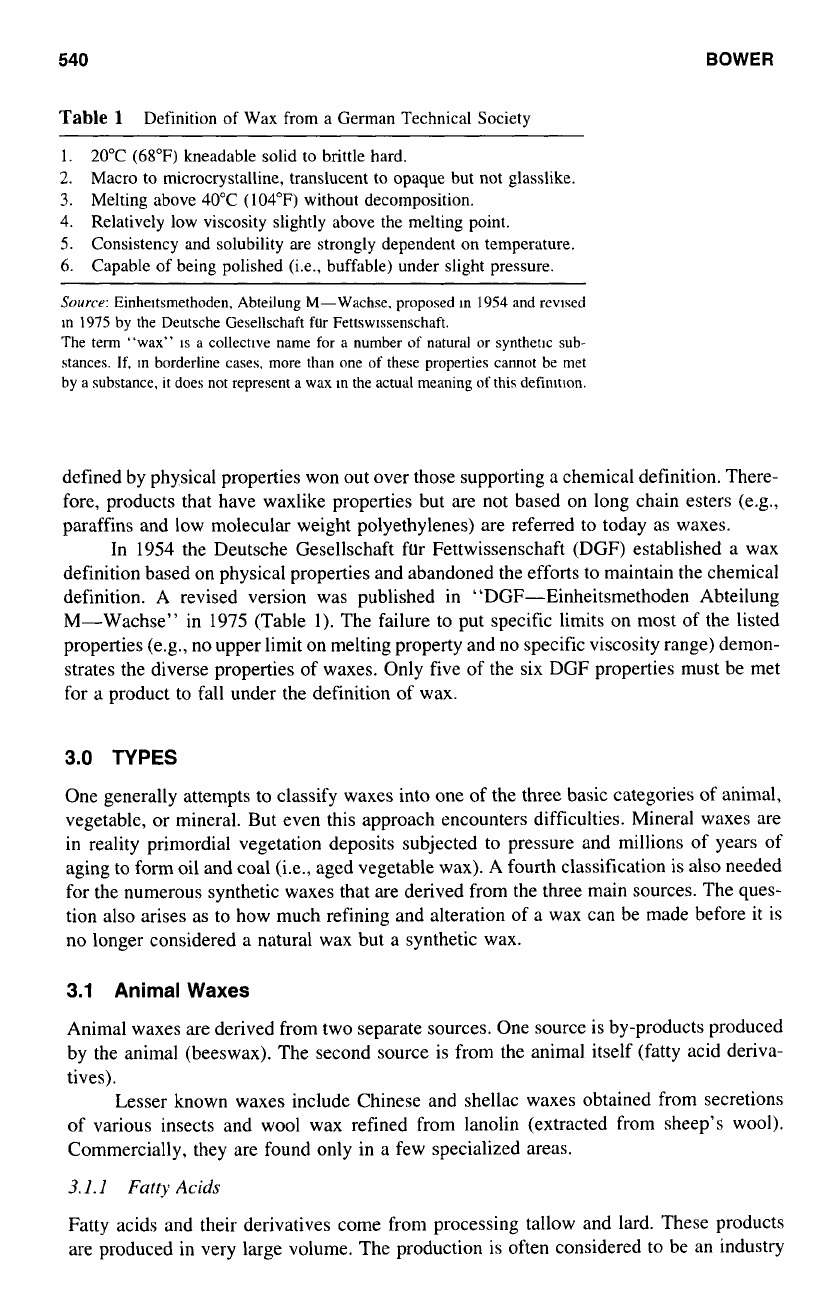
540
BOWER
Table
1
Definition of
Wax
from a German Technical Society
1.
20°C
(68°F)
kneadable solid to brittle hard.
2. Macro to microcrystalline, translucent to opaque but not glasslike.
3.
Melting above
40°C
(104’F)
without decomposition.
4.
Relatively
low
viscosity slightly above the melting point.
5.
Consistency and solubility are strongly dependent on temperature.
6.
Capable of being polished (i.e., buffable) under slight pressure.
Source:
Einheltsmethoden, Abteilung M-Wachse, proposed In
1954
and rcvlsed
In
1975
by the Deutsche Gesellschaft
fur
Fettswlssenschaft.
The term “wax”
IS
a collectlve name
for
a number
of
natural
or
synthetic
sub-
stances.
If.
In borderline cases, more than one
of
these properties cannot be met
by a substance,
it
does not represent a wax In the actual meaning of this defimtlon.
defined by physical properties won out over those supporting a chemical definition. There-
fore, products that have waxlike properties but are not based on long chain esters (e.g.,
paraffins and low molecular weight polyethylenes) are referred
to
today as waxes.
In
1954
the Deutsche Gesellschaft fur Fettwissenschaft (DGF) established a wax
definition based on physical properties and abandoned the efforts to maintain the chemical
definition. A revised version was published in “DGF-Einheitsmethoden Abteilung
M-Wachse” in
1975
(Table
1).
The failure to put specific limits on most
of
the listed
properties (e.g., no upper limit on melting property and no specific viscosity range) demon-
strates the diverse properties of waxes. Only five
of
the six DGF properties must be met
for a product to fall under the definition
of
wax.
3.0
TYPES
One generally attempts to classify waxes into one of the three basic categories of animal,
vegetable, or mineral. But even this approach encounters difficulties. Mineral waxes are
in reality primordial vegetation deposits subjected
to
pressure and millions
of
years of
aging to form oil and coal (i.e., aged vegetable wax). A fourth classification is also needed
for the numerous synthetic waxes that are derived from the three main sources. The ques-
tion also arises as to how much refining and alteration of a wax can be made before it is
no longer considered a natural wax but a synthetic wax.
3.1
Animal
Waxes
Animal waxes are derived from two separate sources. One source is by-products produced
by the animal (beeswax). The second source is from the animal itself (fatty acid deriva-
tives).
Lesser known waxes include Chinese and shellac waxes obtained from secretions
of various insects and wool wax refined from lanolin (extracted from sheep’s wool).
Commercially, they are found only in a few specialized areas.
3.1.1
Fatty
Acids
Fatty acids and their derivatives come from processing tallow and lard. These products
are produced in very large volume. The production is often considered
to
be an industry
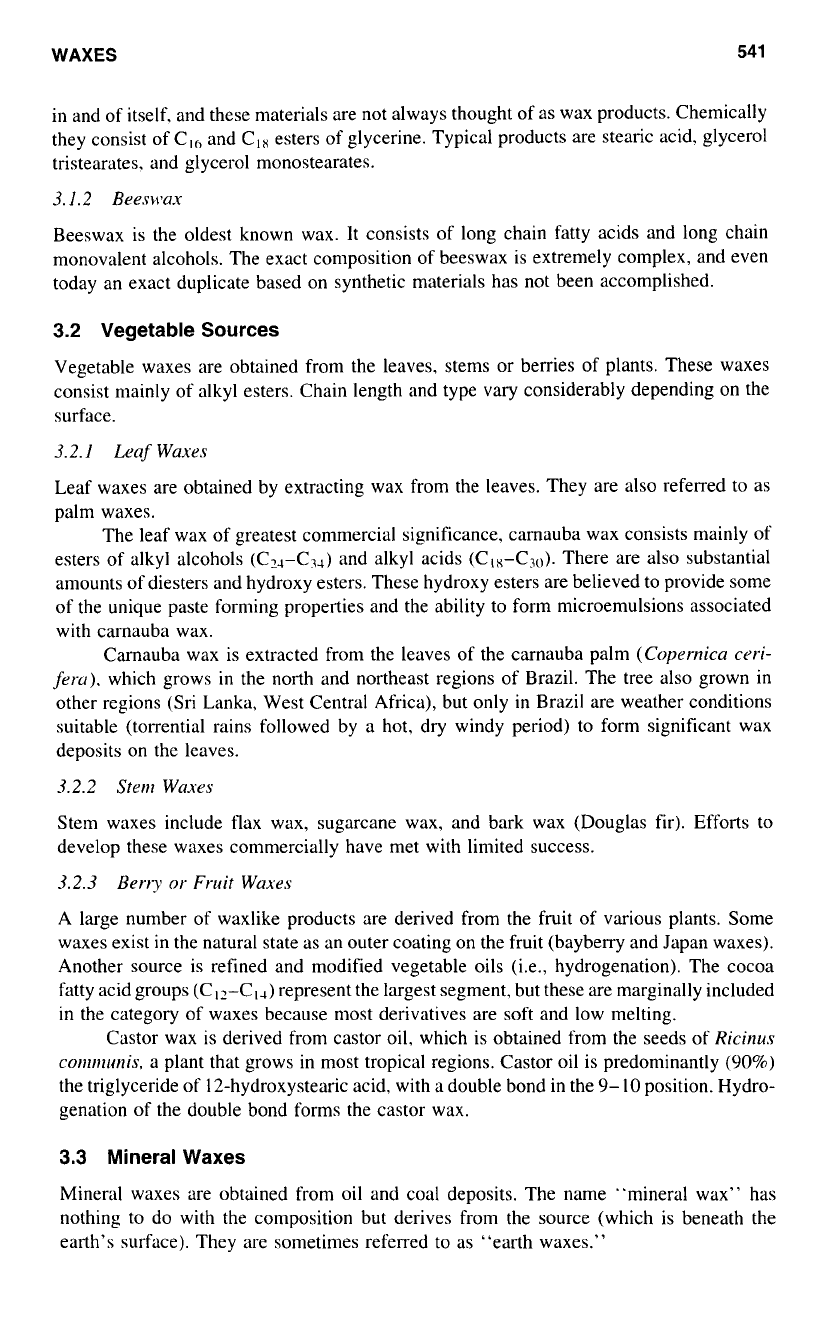
541
in and of itself. and these materials are not always thought of as wax products. Chemically
they consist of C,(, and Clx esters of glycerine. Typical products are stearic acid. glycerol
tristearates. and glycerol monostearates.
3.1.2 Beem,ax
Beeswax is the oldest known wax. It consists of long chain fatty acids and long chain
monovalent alcohols. The exact composition of beeswax is extremely complex, and even
today an exact duplicate based on synthetic materials has not been accomplished.
3.2
Vegetable
Sources
Vegetable waxes are obtained from the leaves, stems or berries of plants. These waxes
consist mainly of alkyl esters. Chain length and type vary considerably depending on the
surface.
3.2.1
Lmf
Waxes
Leaf waxes are obtained by extracting wax from the leaves. They are also referred to as
palm waxes.
The leaf wax
of
greatest commercial significance, carnauba wax consists mainly of
esters
of
alkyl alcohols (ClJ-C3,) and alkyl acids (Clx-C30). There are also substantial
amounts
of
diesters and hydroxy esters. These hydroxy esters are believed to provide some
of
the unique paste forming properties and the ability to form microemulsions associated
with carnauba wax.
Carnauba wax is extracted from the leaves of the carnauba palm
(Copernica
crri-
feru).
which grows in the north and northeast regions of Brazil. The tree also grown in
other regions (Sri Lanka, West Central Africa), but
only
in Brazil are weather conditions
suitable (torrential rains followed by
a
hot, dry windy period) to form significant wax
deposits on the leaves.
3.2.2 Stern
Waxes
Stem waxes include tlax wax, sugarcane wax, and bark wax (Douglas fir). Efforts
to
develop these waxes commercially have met with limited success.
3.2.3 Berry
or
Fruit
Waxes
A
large number of waxlike products are derived from the fruit
of
various plants. Some
waxes exist in the natural state as an outer coating on the fruit (bayberry and Japan waxes).
Another source is refined and modified vegetable oils (i.e., hydrogenation). The cocoa
fatty acid groups (CI+21J) represent the largest segment, but these are marginally included
in the category of waxes because most derivatives are soft and low melting.
Castor wax is derived from castor oil, which is obtained from the seeds of
Ricirlus
co~~zr~z~~r~is,
a
plant that grows in most tropical regions. Castor oil is predominantly
(90%)
the triglyceride
of
12-hydroxystearic acid, with
a
double bond in the
9-
10
position. Hydro-
genation of the double bond forms the castor wax.
3.3
Mineral
Waxes
Mineral waxes are obtained from oil and coal deposits. The name “mineral wax’’ has
nothing to do with the composition but derives from the source (which is beneath the
earth’s surface). They are sometimes referred to as “earth waxes.”
